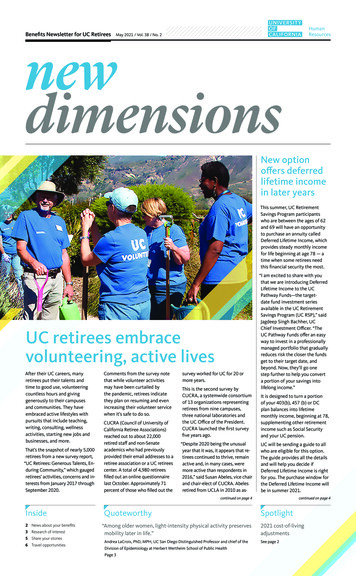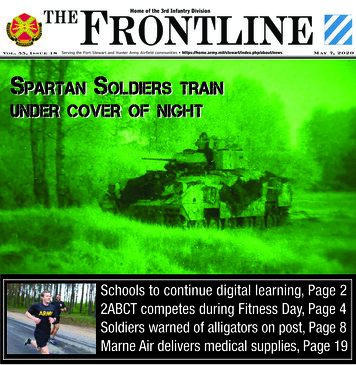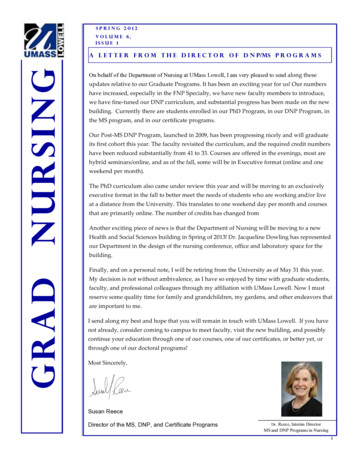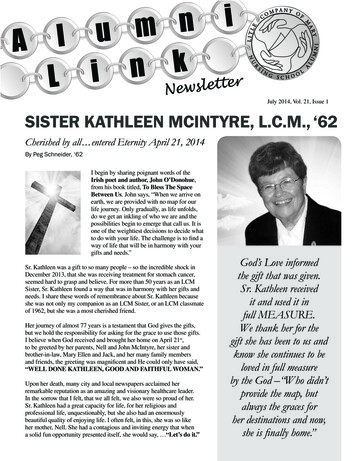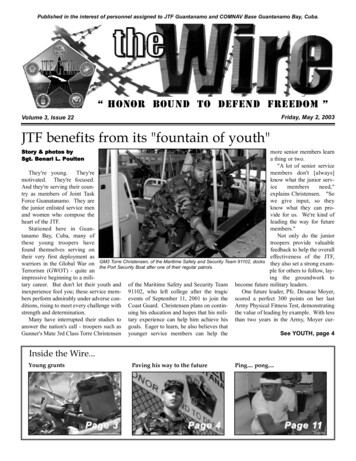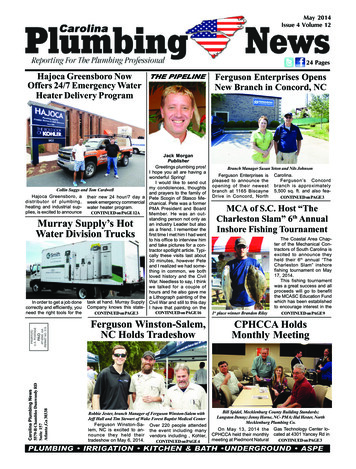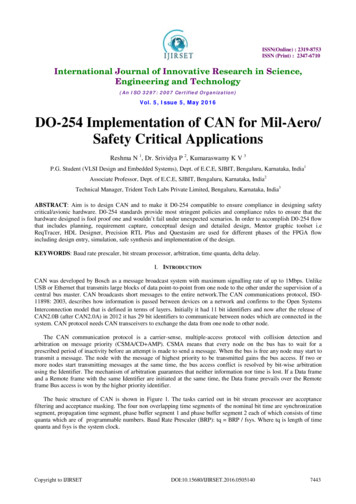
Transcription
ISSN(Online) : 2319-8753ISSN (Print) : 2347-6710International Journal of Innovative Research in Science,Engineering and Technology(An ISO 3297: 2007 Certified Organization)Vol. 5, Issue 5, May 2016DO-254 Implementation of CAN for Mil-Aero/Safety Critical ApplicationsReshma N 1, Dr. Srividya P 2, Kumaraswamy K V 3P.G. Student (VLSI Design and Embedded Systems), Dept. of E.C.E, SJBIT, Bengaluru, Karnataka, India1Associate Professor, Dept. of E.C.E, SJBIT, Bengaluru, Karnataka, India2Technical Manager, Trident Tech Labs Private Limited, Bengaluru, Karnataka, India3ABSTRACT: Aim is to design CAN and to make it D0-254 compatible to ensure compliance in designing safetycritical/avionic hardware. D0-254 standards provide most stringent policies and compliance rules to ensure that thehardware designed is fool proof one and wouldn’t fail under unexpected scenarios. In order to accomplish D0-254 flowthat includes planning, requirement capture, conceptual design and detailed design, Mentor graphic toolset i.eReqTracer, HDL Designer, Precision RTL Plus and Questasim are used for different phases of the FPGA flowincluding design entry, simulation, safe synthesis and implementation of the design.KEYWORDS: Baud rate prescaler, bit stream processor, arbitration, time quanta, delta delay.I. INTRODUCTIONCAN was developed by Bosch as a message broadcast system with maximum signalling rate of up to 1Mbps. UnlikeUSB or Ethernet that transmits large blocks of data point-to-point from one node to the other under the supervision of acentral bus master. CAN broadcasts short messages to the entire network.The CAN communications protocol, ISO11898: 2003, describes how information is passed between devices on a network and confirms to the Open SystemsInterconnection model that is defined in terms of layers. Initially it had 11 bit identifiers and now after the release ofCAN2.0B (after CAN2.0A) in 2012 it has 29 bit identifiers to communicate between nodes which are connected in thesystem. CAN protocol needs CAN transceivers to exchange the data from one node to other node.The CAN communication protocol is a carrier-sense, multiple-access protocol with collision detection andarbitration on message priority (CSMA/CD AMP). CSMA means that every node on the bus has to wait for aprescribed period of inactivity before an attempt is made to send a message. When the bus is free any node may start totransmit a message. The node with the message of highest priority to be transmitted gains the bus access. If two ormore nodes start transmitting messages at the same time, the bus access conflict is resolved by bit-wise arbitrationusing the Identifier. The mechanism of arbitration guarantees that neither information nor time is lost. If a Data frameand a Remote frame with the same Identifier are initiated at the same time, the Data frame prevails over the Remoteframe Bus access is won by the higher priority identifier.The basic structure of CAN is shown in Figure 1. The tasks carried out in bit stream processor are acceptancefiltering and acceptance masking. The four non overlapping time segments of the nominal bit time are synchronizationsegment, propagation time segment, phase buffer segment 1 and phase buffer segment 2 each of which consists of timequanta which are of programmable numbers. Baud Rate Prescaler (BRP): tq BRP / fsys. Where tq is length of timequanta and fsys is the system clock.Copyright to IJIRSETDOI:10.15680/IJIRSET.2016.05051407443
ISSN(Online) : 2319-8753ISSN (Print) : 2347-6710International Journal of Innovative Research in Science,Engineering and Technology(An ISO 3297: 2007 Certified Organization)Vol. 5, Issue 5, May 2016Figure 1: structure of CAN protocol controllerDO-254 provides guidance on the processes and methodologies which should be applied in the development andverification of electronic hardware to achieve an acceptable level of confidence such that the end hardware functionscorrectly and will be in compliance with airworthiness requirements. DO-254 is an avionics industry document entitled“Design Assurance Guidance for Airborne Electronic Hardware” that focuses to ensure product performs its intendedfunction (via design assurance process). It was invoked as law by the FAA/EASA in 2005 and it is now a worldwidestandard for aviation design and also spreading into military applications. It is also influencing other safety-criticalindustries.If the failure of a system could lead to consequences that are determined to be unacceptable, then the system issafety-critical and CAN is one such system. Paper is organized as follows. Section II describes various systems onController Area Network systems being proposed. The flow diagram in section III represents the DO-254 flow. SectionIV presents experimental results showing simulation waveforms, RTL schematic and area report. Finally, Section Vpresents the conclusion.II. RELATED WORKA methodology was proposed using Controller Area Network (CAN), protocol, standards and their architecture.Where in, overview of the CAN applications both in the non-industrial and the industrial field, it was also used in homeautomation [1]. Later a system that discusses about Control Area Network for vehicle law enforcement applicationbased on the requirements of an advanced law enforcement vehicle demonstrator and Control Area networkarchitecture has been implemented [3].In an effort to reduce the amount of point to point wiring in law enforcement vehicles and to centralize thecommunication between devices, CAN is suggested as a means to serialize data communication within the vehicleenvironment. A comparative case study of distributed network architectures [4] for different automotive applicationswas made and a table which distinguishes the various protocols such as Control Area Network (CAN), LocalInterconnect Network (LIN), and Media Oriented System Transport (MOST) was published. Then, CAN protocol usingPIC for vehicle monitoring system was implemented [4]. Controller Area Network (CAN) is mainly used in theautomotive and automation industries due to its ease in use, low cost and the reduction in wiring complexity.Copyright to IJIRSETDOI:10.15680/IJIRSET.2016.05051407444
ISSN(Online) : 2319-8753ISSN (Print) : 2347-6710International Journal of Innovative Research in Science,Engineering and Technology(An ISO 3297: 2007 Certified Organization)Vol. 5, Issue 5, May 2016DO-254 flowThe DO-254 FLOW shown in Figure 2 is explained as follows: The planning phase is crucial in the DO-254 project lifecycle as it defines how all the aspects of projectachieve DO-254 compliance.Design requirements are tracked by ReqTracer along with the test results throughout the entire productdevelopment cycle, ultimately providing real-time measurement of progress.Code is created in the HDL Designer such that the pre-defined DO-254 coding rules are met. This helps in thequality assessment of the code and also the code is tagged to the requirements. Coding is done such that thedesign assurance mandates are met and the pre-defined rule-set makes it is easy to fix the violations.Figure 2: DO-254 Flow Using Questasim the code is then compiled and simulated with code coverage which helps in coverage- drivenverification and verification management. Simulation wave windows can be expanded to show delta delays.Dataflow window allows to explore physical connectivity of the design and to find out the cause of failure ifthere is any.For the physical synthesis Precision RTL is the Flagship FPGA Synthesis solution from Mentor Graphicswhich is Vendor-Independent Solution for breakthrough productivity and best suited for Commercial, MilAero & Safety Critical ApplicationsSynthesis and place and route processes help to bridge the transition from design to implementation. If theRTL code is synthesizable, it can be easily dumped to the FPGA.III. EXPERIMENTAL RESULTSThe verilog compiler of Questasim compiles the CAN source code into retargetable, executable code. It is thensimulated. Figure 3 (a) shows the simulation waveforms for acceptance filtering and acceptance masking carried out inbit stream processor. There are 2 sets of registers that handle selective receive of CAN message. The CAN acceptanceCopyright to IJIRSETDOI:10.15680/IJIRSET.2016.05051407445
ISSN(Online) : 2319-8753ISSN (Print) : 2347-6710International Journal of Innovative Research in Science,Engineering and Technology(An ISO 3297: 2007 Certified Organization)Vol. 5, Issue 5, May 2016mask set of registers are used to indicate which of the bits in received CAN frame id will be used by CAN filter set ofregisters. CAN filter set of registers compare received CAN id bits with corresponding bits in CAN filter register set. Ifmatch is seen between filter and CAN id, CAN frame is accepted by CAN engine and transferred to CAN receivebuffer else dropped. Fig 3 (b) show the simulation results of the port outputs respectively.3(a)3 (b)High-level RTL schematics help to determine the impact of coding styles while detailed technology schematicsshow where and how device specific resources such as RAM and ROM are utilized. Figures 4 (a) and (b) represent thehigh-level RTL schematics for CAN and acceptance filtering in particular respectively obtained using Precision RTLPlus.4(a)Copyright to IJIRSET4 (b)DOI:10.15680/IJIRSET.2016.05051407446
ISSN(Online) : 2319-8753ISSN (Print) : 2347-6710International Journal of Innovative Research in Science,Engineering and Technology(An ISO 3297: 2007 Certified Organization)Vol. 5, Issue 5, May 20165(a)5 (b)Area report is the detailed description of device utilization and Figure 5(a) shows the area utilization of CAN beforeoptimization. Figure 5(b) represents the design checker display indicating that no DO-254 violations are detected whichimplies that the code is DO-254 compatible.IV.CONCLUSIONThe design requirements are traced using ReqTracer. For the conceptual design, Code is created in the HDLDesigner such that the pre-defined DO-254 coding rules are met. The design is then Compiled and Simulated usingQuestasim with the code coverage. Synthesis is successfully done using Precision RTL Plus. The design for CAN isDO-254 compatible and can be used for mil-aero and safety critical applications.REFERENCES[1][2][3][4][5][6]H. F. Othman, Y. R. Aji, F. T. Fakhreddin and A. R. Al-Ali, “Controller Area Networks: Evolution and Applications,” IEEE, pp. 3088-3093,2010.Marino A. and Schmalzel J., “Control Area Network for In-Vehicle Law Enforcement Applications”, Sensors Applications Symposium IEEE ,pp. 1-5, 2004.Johnson, R. Wayne, Evans, John L. Jacobsen, Peter, Thompson, James R and Christopher Mark, “The Changing Automotive Environment:High-Temperature Electronics”, IEEE Transactions on Electronics Packaging Manufacturing, pp. 164-176, 2004.PresiT.P, “Design and Development Of PIC Microcontroller Based Vehicle Monitoring System Using Controller Area Network (CAN)Protocol,” Information and communication Embedded Systems, pp. 1070-1076, 2013.Nir Weintroub and Sani Jabsheh, “DO-254 HIGH-SPEED INTERFACES COMPLIANCE,” 33rd Digital Avionics Systems Conference, PP5-9,October2014.Mr.K.Kalaiyarasu , “Design of an Automotive Safety System using Controller Area Network,”, International Conference on Robotics,Automation, Control and Embedded Systems – RACE, PP 18-20, 2015BIOGRAPHYReshma N is an M.tech student in the specialization of VLSI Design and Embedded Systems, Dept of E.C.E, SJBIT,Karnataka, India.Dr. Srividya P, specialised in VLSI Design and Embedded Systems, is an Associate Professor, Department ofElectronics and communication Engineering, SJBIT, Karnataka, India.Kumaraswamy K V received B.E, Degree from Mysore University, M.Tech in VLSI Design and Embedded Systems,Degree from Visvesvaraya Technological University, currently pursuing Ph.D in Semiconductor devices, worked inConexant Systems, Infineon Technologies and so on, 22 years of experience in Semiconductor Industries.Copyright to IJIRSETDOI:10.15680/IJIRSET.2016.05051407447
The DO-254 FLOW shown in Figure 2 is explained as follows: The planning phase is crucial in the DO-254 project lifecycle as it defines how all the aspects of project achieve DO-254 compliance. Design requirements are tracked by ReqTracer along with the test results throughout the entire product development cycle, ultimately providing real-time measurement of progress. Code is created in the .

